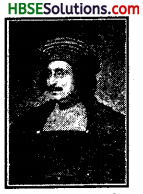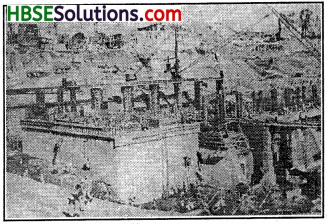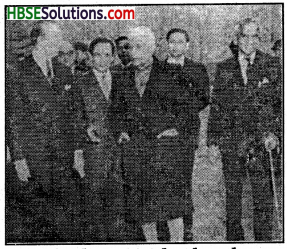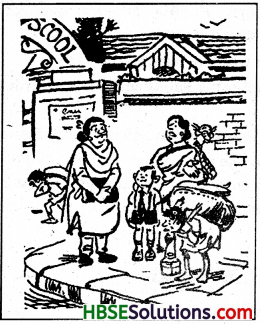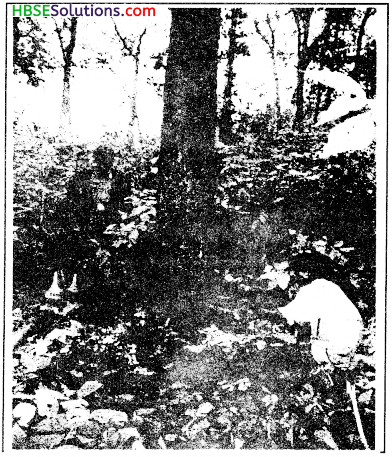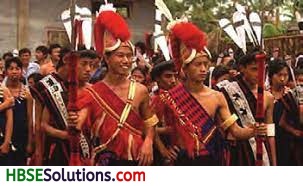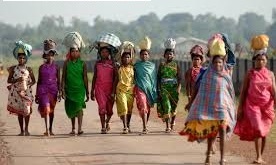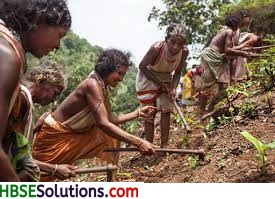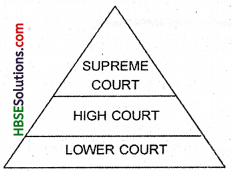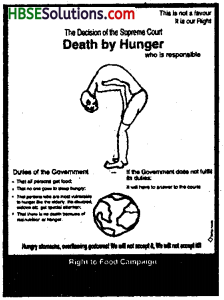HBSE 8th Class Social Science Solutions History Chapter 9 Women, Caste and Reform
Haryana State Board HBSE 8th Class Social Science Solutions History Chapter 9 Women, Caste and Reform Textbook Exercise Questions and Answers.
Haryana Board 8th Class Social Science Solutions History Chapter 9 Women, Caste and Reform
HBSE 8th Class History Women, Caste and Reform Textbook Questions and Answers
LETS IMAGINE
Imagine you are a teacher in the school set-all throughout her life as she was told to be a docile, submissive and obedient person even in times her rights were barred.
Another Muslim girl explained how they were the target of conservative critics teasing them time and again urging them and their families to drop them for school. These pessimists had an inferior eye and negativity for the poor little girls.
However, some aspirational girls decided to cope up with the loss and faced the heartbreaking insult with a calm mind and soul to get better returns in future. They had told me that they readily wanted to adopt the Western mind-set up by Rokeya Hossain. There are 20 girls in your charge. Write an account of the discussions that might have taken place on any one day in the school.
Answer:
I am a women in once of Begum Rokeya Sakhawat Hossain and a teacher at the Calcutta Primary School. Being a teacher, I understand that it is my solemn responsibility to dispel the darkness in my students’ lives and hence decided to gather all views about the same. One of the girls described me the challenges she has faced keeping intact with the values, culture and heritage of India.
Some also embraced my efforts on women reform leaving me overwhelmed. I was filled with ecstatic joy to hear that few bright students wanted to make it to the pinnacle by becoming doctors, nurses, teachers and intelligent home makers. I was impressed by the view that we could even write successful women’s stories.
![]()
LETS DISCUSS
Question 1.
What social ideas did the following people support?
(i) Rammohan Roy
(ii) Dayanand Saraswati
(iii) Veerasalingam Pantalu
(iv) Jyotirao Phule
(v) Pandita Ramabai
(vi) Periyar
(vii) MumtazAli
(viii) Ishwarchandra Vidyasagar
Answer:
(i) Social ideas supported by Raja Rammohan Roy:
- Raja Rammohan Roy focused his attention towards removing the evil practice of Sati.
- He preached in favour of widow remarriage.
- He worked to secure a place of honour for women in the Hindu society. He demanded for them the right of inheritance to property.
- To ensure a place of respect for women, he condemned the practice of polygamy.
- He also supported the study of English literature.
(ii) Social ideas supported by Dayanand Saraswati:
- Dayanand supported widow re-marriage.
- He condemned Sati system.
- He opposed the practice of child marriage.
- He supported education of girls.
- He founded AryaSamaj which worked for the uplift and emancipation of women.
(iii) Social ideas supported by Veersalingam Pantalu:
He supported widow remarriage and formed an association in the Telugu speaking areas of the Madras Presidency.
(iv) Social ideas supported by Jyoti Rao Phule:
- Jyoti Rao Phule supported education for girls. He and his wife opened five schools for girls in and around Pima in 1848.
- Jyoti Rao Phule argued that Brahmans were not superior, just because they were Aryans. He supported the idea that land belonged to indigenous people, the so called low castes.
(v) Social ideas supported by Pandita Ramabai:
- Pandita Ramabai worked for the upliftment of women’s status in society.
- She wrote a book about the miserable lives of upper-caste Hindu women.
- She founded a widow’s home at Puna to provide shelter to widows who had been treated badly by their husbands’ relatives. Here, women were trained so that they could support themselves economically.
(vi) Social ideas supported by Periyar:
- Periyar supported the idea that untouchables were the true upholders of an original Tamil and Dravidian culture which had been subjugated by Brahmins.
- He was of the view that untouchable had to free themselves from all religions in order to achieve social inequality.
- He did not support the authority of Brahmins over lower castes and the domination of men over women. Hence he was a critic of Hindi scriptures which supported these ideas.
(vii) Social ideas supported by Mumtaj Ali:
- Mumtaj Ali supported women’s education. She, alongwith other reformers reinterpreted verses from Koran to support for women’s education.
- Women were encouraged to read about religion and domestic management in language they could understand.
(viii) Social ideas supported by Ishwar Chander Vidyasagar:
- He carried a crusade for widow’s remarriage. He also tried to legalise widow’s remarriage.
- He raised his voice against child marriage.
- He opposed polygamy.
- He opened girls school which he ran at his own expense. Orthodox families criticised saying that after receiving western education, girls would not be able to perform their duties as mother and wives.
Question 2.
State whether true or false:
(a) When the British captured Bengal they framed many laws to regulate the rules regarding marriage, adoption, inheritance of property etc.
(b) Social reformers had to discard the ancient texts in order to argue for reform in social practices.
(c) Reformers get full support from all sections of the people of the country.
(d) The Child Marriage Restraint Act was passed in 1829.
Answer:
(a) True
(b) True
(c) False
(d) False.
Question 3.
How did the knowledge of ancient texts help the reformers promote new laws?
Answer:
The reformers worked for improving the status of women in the society using the knowledge of ancient texts. For example:
(i) Raja Ram Mohan Roy studied Hindu religious books and through his writings in Sanskrit, Persian and other languages emphasised that widow-burning had no sanction in ancient text. He cited verses from ancient texts to show that existing evil practices were against early traditions.
(ii) Ishwar Chander Vidyasagar used ancient text to suggest that widows could remarry.
(iii) Swami Dayanand quoted from Vedas that many social evils of today had no religious sanctions.
(iv) Mumtaz Ali reinterpreted verses from Koran to condemn the illiteracy among women and advocated for their education.
![]()
Question 4.
What were the different reasons people have for not sending girls to school?
Answer:
The people did not want to send girls to school because:
(i) They feared that schools would take girls away from home, prevent them from doing their domestic duties.
(ii) They believed that girls should stay away from public places. They feared that passing through public places would have a corrupting influence on them.
Question 5.
Why were Christian missionaries attacked by many people in the country? Would some people have supported them too? If so, for what reasons?
Answer:
(i) Christian missionaries were attacked by many people in the country because they did not like the activities of missionaries. Many Hindu nationalists felt that Hindu women were adopting western ways of living and that this would corrupt Hindu culture and erode family values.
(ii) Some people had supported them too for reasons such as:
- Christian missionaries began setting up schools for tribal groups and lower caste children. These children were equipped with some resources to make their way into a changing world.
- Christian missionaries supported women’s freedom and social equality. They condemned Sati system.
Question 6.
In the British period, what new opportunities opened up for people who came from castes that were regarded as “low”?
Answer:
The new opportunities opened up for people in lower castes:
(i) Raja Ram Mohan Roy through his writings was critical of caste-system.
(ii) The Prarthna Samaj adhered to the tradition of Bhakti that believed in spiritual equality of all castes.
(iii) Many reformers of this period violated caste taboos on food and touch.
(iv) Christian missionaries began setting up schools for tribal groups and lower castes children.
(v) The poor from villages and small towns, many of them from low castes, began moving to cities where there was demand for new labour.
Question 7.
How did Jyoti Rao the reformer justify their criticism of caste inequality in society?
Answer:
(a) Jyoti Rao opposed the idea that Brahmins were superiors, just because they were Aryans. He argued that Aryans were foreigners, who came from outside the subcontinent, and defeated and subjugated the true children of the country those who had lived here before coming of the Aryans.
(b) He said that the “upper” castes had no right to their land and powers in fact, the land belonged to indigenous people, the so-called low-castes.
(c) He proposed that Shudras and AtiShudras should unite to challenge caste discrimination.
(d) He wrote a book named Gulamgiri meaning slavery.
Question 8.
Why did Phule dedicate his book Gulamgiri to the American movement to free slaves?
Answer:
Phule dedicated his book ‘Gulamgiri’ to the American movement to free slaves because he wanted to establish a link between the conditions of the lower castes in India and the black slaves in America. As ten years before he wrote his book in 1873, the American Civil War had been fought leading to the end of slavery in America.
Question 9.
What did Ambedkar want to achieve through the temple entry movement?
Answer:
Temple Entry movement was started by Ambedkar in 1927 because Brahmin priests were outraged when the Dalits used water from the temple tank. Through three temple entry movements between 1927 and 1935, he wanted to make everyone see the power of caste prejudices within society.
Question 10.
Why were Jyoti Rao Phule and Ramaswamy Naicker critical of the national movement? Did their criticism help the national struggle in any way?
Answer:
(i) Jyoti Rao Phule was critical of the anti-colonial nationalism that was preached by upper-castes leaders. He wanted Indians to know that the unity between high and low in entire country was only way they could progress.
Ramaswami Naicker also became critical of the national movement when as a member of the Congress he attended a feast organised by the nationalists. He found the seating arrangement followed caste distinctions. He founded the Self Respect Movement for untouchables.
(ii) Their assertions helped national struggles as they continued beyond the colonial period and are still going over the yeasrs. Their ideas were respected at many places people united for a stronger national movement. The forceful speeches, writings and movements of lower-caste leaders did lead to rethinking and some self-criticism among upper-caste nationalist leaders.
![]()
HBSE 8th Class History Women, Caste and Reform Important Questions and Answers
Very Short Answer Type Questions
Question 1.
Who is called ‘Sati’?
Answer:
A widow chooses her death by burning herself on the funeral pyre of her husband is called ‘Sati’.
Question 2.
Write the name of some social evils directly related with the Indian women of 19th century.
Answer:
1. Sati
2. Social inequality or injustice,
3. Illiteracy
4. Child-marriage
5. Dowry
6. No right to parent property
7. Polygamy
8. Easy divorce
9. Veil-system
10. Easy divorce etc.
Question 3.
Who were Aryans according to Phule?
Answer:
According to Phule, Aryans were foreigners, who came from outside the subcontinent, and defeated and subjugated the true children of the country.
Question 4.
Whom did Phule dedicate the book ‘Gulamgiri’?
Answer:
Phule dedicated his book to all those Americans who had fought to free slaves, thus establishing a link between the conditions of the “lower” castes in India and the black slave in America.
Question 5.
Whom did Periyar criticise?
Answer:
Periyar was an outspoken critic of Hindu scriptures, especially the Codes of Manu, the ancient law given and the Bhagawad Gita and the Ramayana.
Question 6.
What were the demands of the Indian Social Conference formed under Mahadev Govind Ranade in 1887?
Answer:
The Indian Social Conference was formed by Mahadev Govind Ranade in 1887. Its demands were as under: .
1. Abolition of caste system.
2. Intercaste marriages.
3. Raising the marriageable age.
4. Widow remarriage.
5. Women’s education.
6. Setting of religious disputes by the Panchayats.
7. Discouragement of polygamy.
![]()
Question 7.
Name any two reformers of sought India who dedicated their lives for the upliftment of women and oppressed castes.
Answer:
1. Mahatma Jyotiba Phule who played a leading role in the spread of women education, particularly of the oppressed castes.
2. Kandukuri Veersalingam who poineered the cause of widow remarriage and women education in Andhra Pradesh.
Question 8.
Who was the founder of Arya Samaj? Give an account of any social and religious reforms made by this institution.
Answer:
Swami Dayanand was the founder of Arya Samaj. The social and religious reforms made by Arya Samaj were as under:
(i) This institution raised voice against caste system.
(ii) It opposed sati system, child marriage and infanticide.
(iii) It gave permission for widow remarriage and laid emphasis on women education.
Short Answer Type Questions
Question 1.
Write nearly five lines about some of the progressive ideas.of Raja Rammohun Roy.
Answer:
1. Raja Rammohun Roy opposed ‘sati’ system and urged the British government to pass an act against this evil. He got success in his effort in 1829.
2. Roy favoured widow remarriage.
3. He was keen to spread the knowledge of Western education in the country and bring about greater freedom and equality for w men.
4. Raja Rammohun Roy published some newspapers and wrote about the way women were forced to bear the burden of domestic work, confined to the home and the kitchen, and not allowed to move out and became educated.
Question 2.
Dicuss the work and contribution of Ishwar Chandra Vidyasagar for the upliftment of women.
Answer:
- Ishwar Chandra Vidyasagar is rememered for his contribution to the upliftment of India’s oppressed or miserable women.
- He did a lot for the education of women. Besides, doing a lot for education he also waged a long struggle for widow remarriage.
- It was due to his efforts the Hindu Widow Remarriage Act, 1856 was passed which allowed the widows to remarriage.
- Ishwar Chandra also protested against child marriage and polygamy. He had also opposed the sati system and promoted the education of girls and started first a school for them.
Question 3.
What is meant by the loss of caste status?
Answer:
Those people who laboured to keep cities and villages clean or worked at jobs that upper castes considered “polluting”, they were considered to have a loss of caste status.
![]()
Question 4.
Name any five social reformers in India.
Answer:
- Raja Rammohan Roy
- Ishwar- chandra Vidyasagar
- Swami Dayanand Saraswati
- Jyotirao Phule and
- E.V. Ramaswamy Naicker (Periyar).
Question 4.
Why was the curriculum not the same for both boys and girls? Which school provided first the same kind of learning for the two?
Answer:
(i) Initially, the people believed that the curriculum for girls should be easier than that for boys.
(ii) The Hindu Mahila Vidyalaya was one of the first institutions to provide girls with the kind of learning that was usual for boys at that time.
Question 5.
When was the Child Marriage Restraint Act passed? What were its provisions?
Answer:
1. The Child Marriage Restraint Act was passed in 1929.
2. According to the Act, no man below the age of 18 and woman below the age of 16 could marry.
Question 6.
Name any five women social reformers of 18th and 19th centuries in India.
Answer:
- Begum Rokeya Sakhawat
- Tarabai Shinde
- Pandita Ramabai
- Rashsundari Debi
- Begum of Bhopal.
Question 7.
When was the law regarding widow remarriage passed? Who suggested this view initially?
Answer:
1. This law was passed in 1856 that permits widow remarriage.
2. The famous social reformers Ishwar- chandra Vidyasagar used the ancient texts to suggest that widows could remarry. His suggestion was adopted by British officials and they made a law in this regard.
Question 8.
Name any three Muslim social reformers who emphasized on women’s education.
Answer:
1. Mumtaz Ali
2. Begum Rokeya Sakhawat Hossain.
Long Answer Type Questions
Question 1.
What were the demands of the Indian Social Conference formed under Govind Ranade in 1887?
Or
Examine the contribution of Mahadev Govind Ranade to social reforms.
Answer:
He founded the Indian Social Conference in 1887. This Conference aimed at:
1. Intercaste marriages and raising the marriageable age.
2. Advocated abolition of caste system.
3. Tried for widow remarriage.
4. Women education.
5. Discouragement to polygamy.
6. Improvement in the conditions of the outcastes.
7. Settlement of all religious disputes between the Hindus and Muslims by Panchayats.
Question 2.
Mention two factors which contributed to the rise of the social reforms movements in India.
Answer:
1. The Caste System and Untou- chability:
In the Indian society the caste system was a big evil. The people of high castes used to exploit and hate the people of low castes. This evil gave rise to certain economic, political and social imbalances in the Indian social life which caused much harm to the society.
2. Deplorable condition of Women:
In those days women in Indian society suffered a lot because of many social evils like the customs of Sati, purdah system, the child marriage, illiteracy etc. The widows were not allowed to remarry at any cost.
Question 3.
Write three advantages that the beginning of the Press had on Indian society.
Answer:
1. It made Indians aware of need for reforming their religious and social evils.
2. It spread knowledge and revolutionary ideas among the people.
3. It became the means for spreading nationalist feelings and mobilising public opinion for the freedom struggle.
Question 4.
Evaluate the impact of reform movements of the 19th century towards, the emancipation of women.
Answer:
1. Raja Ram Mohan Roy and the Brahmo Samaj understood the importance of women’s education and gave it strong support. They also supported widow remarriage and opposed the sati system.
2. Devendra Nath Thakur established Tatvabhodhini Sabha in 1839 and advocated the causes of widow remarriage, abolition of polygamy and promotion of women’s education.
3. Ishwar Chandra Vidyasagar dedicated himself for the cause of the emancipation of women. It was due to his efforts that legal obstacles to the marriage of widows were removed through a law in 1856. He played a leading role in promoting education of girls. He started and helped the setting up of a number of schools for girls.
![]()
Question 5.
What is meant by Aligarh Movement? What was its contribution?
Answer:
Sayyid Ahmed Khan established the Mohammedan Anglo Oriental College at Aligarh in 1875 which later developed into the Aligarh Muslim University. It was because of this, that the movment started by Sir Sayyid is known as the Aligarh Movement.
Contribution of the Aligarh Movement:
(i) The Aligarh Muslim University became one of the most important breeding grounds of new trends in the political, social and cultural life of the Muslims.
(ii) It awakened the Muslims and soon Aligarh became the centre for religious and cultural revival of the Muslim community.
(iii) Sir Sayyid also tried to reform the social abuses in the Muslim community.
(iv) He condemned the purdah system and easy divorce.
Question 6.
Explain the impact of the social religious reform movements of the 19th century on Indian society.
Answer:
1. The sati system was abolished through legislation by Lord Bentick (1829).
2. Widow remarriage was legalized in 1856.
3. The caste system became a bit liberal and untouchability also got reduced.
4. The child marriage was prohibited by law in 1872.
5. Many educational institutions were established for educating the masses.
Question 7.
What was done by Raja Rammohun Roy for changing the lives of widows?
Or
“Rammohun Roy was particularly moved by the problems widows faced in their lives.” Discuss the statement.
Answer:
Raja Rammohun Roy and his efforts to changing the lives of widows:
1. Raja Rammohun Roy was particularly moved by the problems widow faced in their lives. He began a campaign against the practice of sati.
2. Rammohun Roy was well versed in Sanskrit, Persian and several other Indian and European languages. He tried to show through his writings that the practice of widow burning had no sanction in ancient texts.
3. Raja Rammohun Roy approaches many British officials, who had also begun to criticise Indian traditions and customs. They were therefore more than willing to listen to Rammohun who has reputed to be a learned man. Govemer General Wiliiam Bentick was convinced with the ideas of Rammohun Roy. Therefore, in 1829 an Act was passed and sati was banned.
Question 8.
Write an essay on the topic “Women wrote about women” during the social I reform movement period of India.
Answer:
1. Works of Muslim women for (or about) women:
From the early twentieth century, Muslim women like the Begums of Bhopal played a notable role in promoting education among women. They founded a primary school for girls at Aligarh. Another remarkable woman, Begum Rokeya Sakhawat Hossain started school for Muslim girls in Patna and Calcutta. She was a fearless critic of conservative ideas, arguing that religious leaders of every faith accorded an inferior place to women.
2. Work of Tarabai Shinde:
By the 1880s, Indian women began to enter universities. Some of them trained to be doctors, some became teachers. Many women began to write and publish their critical views on the place of women in society. Tarabai Shinde, a woman educated at home at Poona, published a book, Stripurushtulna, (A comparison between Women and Men), criticising the social differences between men and women.
3. Literary work of Pandita Ramabai:
Pandita Ramabai, a great scholar of Sanskrit, felt that Hinduism was oppressive towards women, and wrote a book about the miserable lives of upper-caste Hindu women. She founded a widows’ home at Poona to provide shelter to widows who had been treated badly by their husbands’ relatives. Here women were trained so that they could support themselves economically.
Question 9.
With reference to “Women wrote about women” discuss the impacts of women awakening on the following:
(a) The orthodox of the Indian society.
(b) Impact on other women.
(c) Impact on national leaders like J.L. Nehru and Subhash Chandra Bose.
Answer:
(a) Impact on Orthodox:
It is an accepted fact that women awakening and works as writers all these alarmed the orthodox. For instance, many Hindu nationalists felt that Hindu women were adopting Western ways and that this would corrupt Hindu culture and erode family values. Orthodox Muslims were also worried about the impact of these changes.
(b) Impact on other women:
By the end of the nineteenth century, women themselves were actively working for reform. They wrote books, edited magazines, founded schools and training centres, and set up women’s associations. From the early twentieth century, they formed political pressure groups to push through laws for female suffrage (the right to vote) and better health care and education for women. Some of them joined various kinds of nationalist and socialist movements from the 1920s.
(c) Impact on leaders like J.L. Nehru and Subhash Chandra Bose:
In the twentieth century, leaders such as Jawaharlal Nehru and Subhash Chandra Bose lent their support to demands for greater equality and freedom for women. Nationalist leaders promised that there would be full suffrage for all men and women after independence. However, till then they asked women to concentrate on the anti-British struggles.
![]()
Question 10.
What were the conditions of women and children in Indian society around two hundred years ago?
Answer:
(a) There was a system of child marriage. Most children were married off at an early age.
(b) Both Hindu and Muslim men could marry more than one wife.
(c) Widows were praised if they choose death by burning themselves on the funeral pyre of their husbands.
(d) Women’s rights to property were also restricted.
(e) Most women had virtually no access to education. People generally believed that if a woman was educated, she would become a widow.
Question 11.
How were people divided along lines of caste?
Answer:
(a) They were divided into Brahmans, Kshatriyas, Vaishyas and Shudras.
(b) Brahmans and Kshatriyas considered themselves as upper casts.
(c) Traders and moneylenders were referred to as Vaishyas.
(d) At the lowest level, there were Shudras.
Women, Caste and Reform Class 8 HBSE Notes
- Infanticide: The practice of killing unwanted babies.
- Untouchables: One of the lowest castes.
- Polygamy: The practice of having more than one wife at the same time.
- Sati System: Burning of widows alongwith their dead husbands.
- Dowry System: The practice of giving valuable articles/or/and cash to girl’s and the boy’s family at the time of their marriage.
- Divorce: The practice of leaving one’s partner after marriage.
- Untouchability: Practice of looking down upon a certain section of people to the extent of not even touching them.
- Upper Castes: Brahmans, Kshatriyas, and Vaishyas were considered the upper castes by the Hindus, in ancient India.
- Shudras: The people of the lowest caste were considered Shudras in ancient, medieval India and even before 26th January 1950. They were considered earlier untouchables also.
- Conservative groups: Orthodox religious or social groups.
- Gulamgiri: Slavery.
HBSE 8th Class Social Science Solutions History Chapter 9 Women, Caste and Reform Read More »
